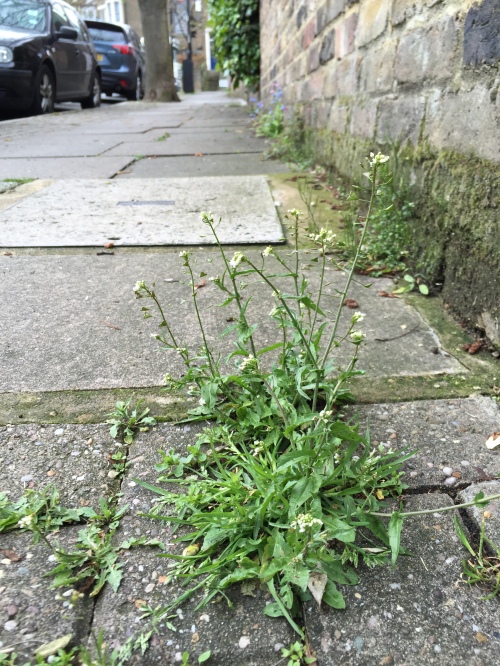Weeds
by Matt
A little while ago I moved on from the garden which, for the most part, provided the recurring inspiration for this blog. As a near full-time gardener employed by its owner, this small yet indomitable and humbling landscape stimulated within me observations of a certain variety; reflections that would sit comfortably together on a page. This is one of the factors which made the act of updating and maintaining this blog relatively effortless, and something of an enjoyable process. Since my departure from the garden however, it has been difficult to continue at the same pace, having yet to settle on any particular focal point or muse.
I thought for a while that I might instead turn my attention to ‘weeds’. Living in a dense city, when your feet experience little besides concrete, tarmac and mortar, the rosettes and protruding stems which unfurl along the surface have become a new novelty to me. Their contrasting green against the pavement and my insatiable need to identify and familiarise myself with any unknown plant variety combine to form an inquisitiveness that regularly stops me in the street. During the winter months it was the thought and visualisation of what flowers would soon spring from the green that most interested and excited me. Recognising leaves beneath their coating of dirt (kicked up by the street-cleaning vehicles and passing pedestrians); knowing, but often not knowing, what colours and forms they would provide if left to flourish or simply survive, this was to me a kind of secret thrill, an escapism or even refuge perhaps. So I began to take photographs and to log the details, with the intention of beginning a new chapter on this blog.
Sadly both time and preoccupation got in the way, and in place of the garden I’ve been absorbed in a couple of garden designs and a book commission. However the photographs remained on my phone and having spotted a particularly colourful curb-side display this morning, I felt compelled to make use of them.
‘The more we seem effortlessly – but temporarily – to eradicate weeds, the less we bother to understand them. They were regarded as powerful medicines, and more pragmatically as important contributors to domestic economy. Their appearance now sparks reflexes, not reasoning. They are regarded as inexplicable and impertinent intruders, quite unconnected with the way we live our lives’.
Richard Mabey writes this in his popular 2010 book, Weeds. It’s a fine observation of the cultural shift in the association between man and weed. To write much more on this subject would be to power-phrase Mabey’s fantastic work. So I wont. But the question that most often reoccurs in my mind when I stumble upon these unexpected ‘conquerers of the concrete’, is one relating to ornamental quality. To me this is the most interesting; what is it in us that will allow some plants to thrive and others not. Why do we take pleasure in a roadside violet, but chemical spray a dandelion. Is it ignorance? Practicality? Taste? ..Or is it a far more complex response. I have always believed that in taking time to learn about the plants around us, we grow to appreciate and often cherish them. However I myself am guilty of overlooking a Shepherd’s Purse flower (Capsella bursa-pastoris) in favour of another, perhaps more showy plant.





I’ve been thinking about this subject a lot lately, as we have a yard filled with weeds, especially dandelions. I would love them if they never went to seed, but I find the seed-puff stage rather ugly. I don’t poison them, but I do rip them out when I can, knowing I’m fighting a losing battle. But yesterday I drove past a yard between home and town that was filled with the seed-puff dandelions, and my first thought was, “Oh, look! It’s as if the yard is filled with soap bubbles.” So I’m trying to change my outlook and see them as charming instead of the early stage of home decay. The urban weeds you have chronicled are very charming,
Hi Vicki, yeah its a funny one. I suspect its easier to love a weed in the city sometimes, for its anarchistic characteristics, than to love one in your herbaceous border or garden path. You can just be the observer in a landscape not belonging to you, whereas it will be harder to let these things be when they’re altering your own planned landscape. And I suppose also that, if being truly pragmatic and unromantic, a city over-run with weeds wouldn’t function, after all, many weeds serve the ecological purpose of filling bare earth, and often even of breaking down surfaces, so are ultimately ‘deconstructors’ of a cityscape.
But regarding the point about which weeds we find attractive and which we don’t (or even what makes a weed a weed), I suppose it often does come down to personal taste and associations with particular plants, e.g. where we’ve seen them growing elsewhere, and what that context is. For example the dandelion creeps up in areas we associate with waste or degradation, and therefore we don’t necessarily like seeing it cropping up in our back gardens. I wonder if out there somewhere someone has constructed a border comprising flowers that only would be considered weeds. And I wonder if given a more formal, planned context, they look different.
Hi Everybody
Some brilliant books to read on this subject are
How to Enjoy Your Weeds. Audrey Wynne Hatfield 1969
Weeds. Charlie Rye 2001
In Search of the Wild Asparagus Hardcover – 18 Jul 1983
by Roy Lancaster
Weeds: Friend or Foe? – An Illustrated Guide to Identifying, Taming and Using Weeds by Sally Roth (22-Feb-2002)(I was the scientific adviser to this).
Enjoy!
All the best,
Anna